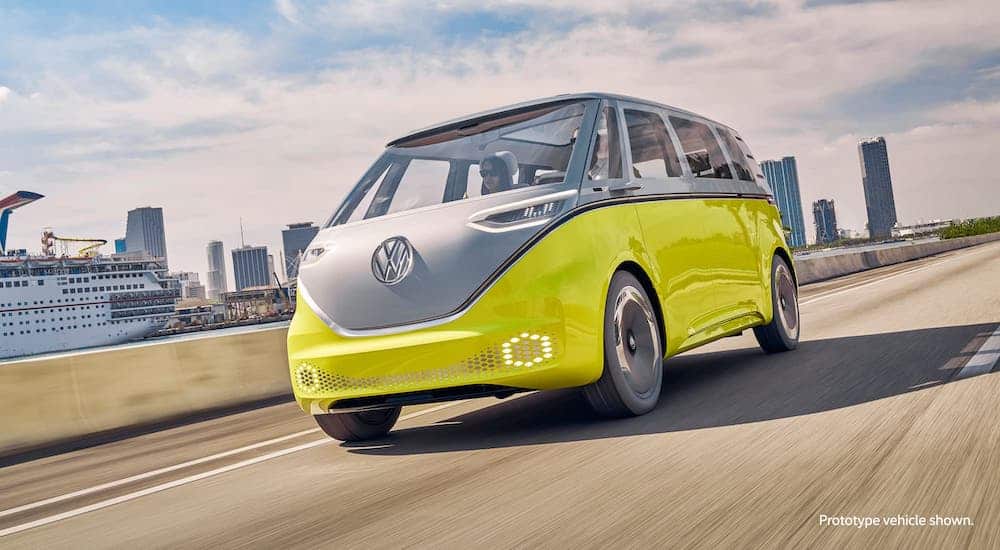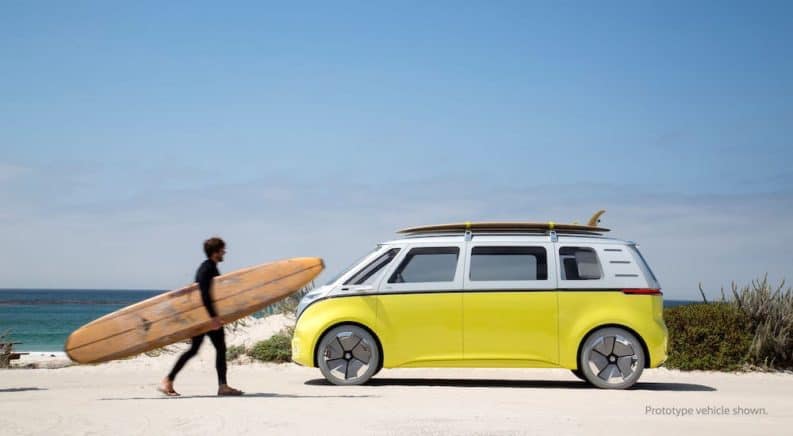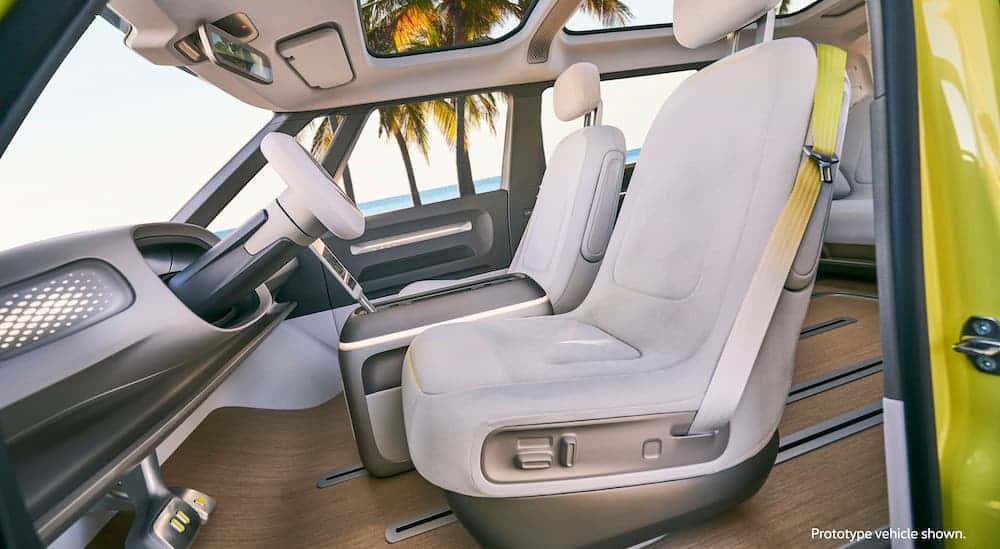The 2020’s are set to be the decade when the electric vehicle finally comes of age. We have already seen the release of electric cars and electric SUVs, and those are set to be joined by electric trucks this year. However, there is one more class of vehicle that is also set to be electrified shortly: the microbus. Inspired by the famous Volkswagen Bus of the 1970’s, Volkswagen has recently confirmed that it is planning an electric 2022 VW Microbus. The concept car of this vehicle (dubbed the I.D. Buzz) was first exhibited back in 2017. And if the production 2022 VW Microbus comes close to resembling the I.D. Buzz, then it will be a unique vehicle packed with novel features that will not only delight fans of the old Volkswagen Bus, but will provide an extremely functional electric vehicle.
However, given that the 2022 VW Microbus is still two years out and that all we have to go on are the I.D. Buzz mockup and computer-generated images, it is impossible to say exactly what the final product will look like. While it will likely closely resemble the I.D. Buzz, as with all concept cars, it is highly likely that many of the more fanciful features of that prototype will run afoul of restrictive laws or high production costs and will be dropped in favor of more conventional solutions. Still, let us take a look back at Volkswagen’s concept car and see what we may expect from the 2022 VW Microbus.
Powerful Electric Motors, but Moderate Battery Capacity

While the exact dimensions of the 2022 VW Microbus have not yet been released, it will almost certainly share the same general size and layout as the I.D. Buzz. This was a fairly large vehicle with three rows of seats, rear cargo space, and a front trunk. Access was similar to a minivan (or the original VW Bus), with two conventional front doors, two sliding middle doors, and a rear liftgate. Altogether, this configuration makes for an extremely practical and functional vehicle, whether you are carrying people, cargo, or a mix of the two. The separate rear cargo area and front trunk are a particularly nice touch that allows for many possibilities for storing different things in different places (say, keeping valuables locked in the trunk while unloading in a public place, or keeping clean items in the trunk while storing dirty gear in the back).
The proposed powertrain of the I.D. Buzz consisted of two electric motors, one front and one rear. This would result in an AWD drive system that should give the 2020 VW Microbus extremely good performance in bad weather or on unimproved roads. And unlike the original underpowered VW bus, as described, the I.D. Buzz would be a rather impressive performer. Not only would it have the instant torque associated with electric vehicles, but its two electric motors would produce a combined 369 horsepower. This would likely lead to a lot of bewildered entry-level sports car owners as they are easily overtaken on the highway by this decidedly un-sporty bus. However, there was also talk of a different powertrain for a cargo version of the I.D. Buzz that consisted of a single rear electric motor with 201 horsepower. Given the somewhat excessive nature of a 369 horsepower AWD Microbus, it is quite possible that the final 2022 VW Microbus will end up using a version of this tamer powertrain. Still, 201 electric horsepower to the rear wheels should produce more than acceptable performance at a significantly lower price point.
The announced battery capacity of the I.D. Buzz was 111 kWh for a range of around 270 miles. While this would make for an acceptable electric vehicle, it is not exactly pushing the boundaries and would limit the 2022 VW Microbus’s utility for long overland journeys. It also is not clear whether that 270 mile estimated range is on the American EPA test cycle or the much more generous European WLTP test cycle. There was also mention of a much smaller 48 kWh battery, possibly in combination with the single electric motor configuration. This would appear to result in a range of around 200 miles, which would be fine for city use but decidedly suboptimal for any real traveling.
A 22nd Century Interior?
The I.D Buzz was filled with novel interior features. The most radical of these was its seating configuration. While it could be set up as a standard three-row vehicle with seating for eight, all of the seats were mounted on tracks on the floor so that they could be easily reconfigured. When combined with the seats’ ability to spin, fold, or even be removed entirely, this resulted in a vehicle with an unmatched level of versatility. Further, the novel seating setup was accompanied by a similarly mobile center console that not only contained a fold-out infotainment screen but which could be transformed into a table for maximum utility. If these interior configurations make it into the production vehicle, the 2022 VW Microbus will be one of the most comfortable and versatile vehicles in history.
Whether traveling, hauling large objects, or enjoying an in-car picnic, the 2022 VW Microbus would be able to fill countless roles. However, it is extremely likely that such a seating arrangement will not be compatible with existing traffic safety regulations, given the obvious issues that it would create with the seatbelt and airbag placement.
The ability of the driver’s seat to rotate away from the windshield and controls would also likely present a safety challenge, although Volkswagen included this feature as it planned for the I.D. Buzz to be a fully self-driving vehicle and wanted the driver to be able to fully relax when the vehicle was operating autonomously. Unfortunately, this radical concept is still unlikely to be legally acceptable just two years from now. Another interesting result of the vehicle’s self-driving capability is that Volkswagen designed the I.D. Buzz with a retractable steering wheel. Not only does this steering wheel fold into the dashboard when not in use, but it contains all the car’s controls, including the gear selector, making for an incredibly uncluttered interior. However, aside from the added expense and questionable value of a folding steering wheel, the design in the I.D. Buzz was a thin oval plate that did not appear to be particularly well-suited to comfortable driving. Therefore, this feature is probably also not going to make it into production.
Still, even if the final 2022 VW Microbus comes with a more traditional interior with fixed three-row seating and a conventional steering wheel and infotainment system, it will lose little of its versatility. With large van doors for easy access and the roomy interior inherent in its boxy design, even a more basic interior setup will give you plenty of space to comfortably carry people and cargo. And by skipping the space-age design elements, Volkswagen will probably be able to deliver the final product at a much lower price point. Whether the planned fully self-driving capability will make it into the final design is more difficult to say, although Volkswagen may well decide to split the difference and make it an option on a higher trim (or even a software upgrade like Tesla) in order to keep prices down.





